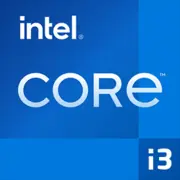Intel Core i3-9320

Intel Core i3-9320: Budget-Prozessor für grundlegende Aufgaben im Jahr 2025
Übersicht, Spezifikationen und praktische Tipps zum Zusammenstellen
1. Hauptmerkmale: Architektur und Leistung
Coffee Lake-Architektur: Bewährte Klassik
Der Intel Core i3-9320 ist ein Vertreter der Coffee Lake-Generation (2018–2019), hergestellt im 14-nm-Verfahren. Trotz seines Alters bleibt der Prozessor für Budget-Bauten relevant, dank:
- 4 Kernen ohne Unterstützung für Hyper-Threading (4 Threads);
- Basisfrequenz von 3,7 GHz (Turbo Boost fehlt);
- Integrierter Grafik UHD Graphics 630;
- TDP von 62 W — niedriger Stromverbrauch.
Wichtige Merkmale:
- Unterstützung von DDR4-2400 (Dual-Channel-Betrieb);
- 8 MB L3-Cache;
- Kompatibilität mit PCIe 3.0 (16 Leitungen).
Leistung im Jahr 2025:
- In synthetischen Tests (Cinebench R23) erzielt der i3-9320 etwa ~4000 Punkte, was nahe an modernen Budget-Prozessoren wie dem Intel N100 ist, aber hinter den 6-Kern AMD Ryzen 5 5500 (~7500 Punkte) zurückbleibt.
- Für alltägliche Aufgaben (Büro, Web-Browsing, 1080p Video) reicht die Leistung allemal aus.
Praktisches Beispiel: In einem Setup mit SSD und 16 GB DDR4 zeigt der Prozessor unter Windows 11 und Linux flüssige Leistung.
2. Kompatible Motherboards
LGA 1151v2-Sockel und Chipsets der 300er-Serie
Für den i3-9320 sind Motherboards mit folgenden Chipsets geeignet:
- H310 — Basisoption (kein Übertakten, begrenzte Anschlüsse);
- B360/H370 — optimale Wahl (USB 3.1 Gen2, M.2);
- Z370/Z390 — für Enthusiasten (Speicherübertaktung, mehr PCIe-Linien).
Wichtige Hinweise:
- Ein BIOS-Update kann für 2018–2019er Motherboards erforderlich sein.
- Vermeiden Sie billige H310 mit schlechter VRM-Kühlung — dies ist entscheidend für die Stabilität.
Beispiele für Modelle:
- ASUS Prime B360M-A (Preis: 75–90 $);
- Gigabyte H370 HD3 (80–100 $).
3. Unterstützter Speicher
DDR4-2400: Balance von Preis und Geschwindigkeit
Der Prozessor arbeitet mit DDR4-2400 im Dual-Channel-Betrieb. Maximale Kapazität — 64 GB (abhängig vom Motherboard).
Empfehlungen:
- Verwenden Sie 2 Module mit 8 GB für den Dual-Channel-Betrieb — das gibt +15–20% Leistung in Spielen und Anwendungen.
- Im Jahr 2025 bleibt DDR4 verfügbar: Ein 16 GB Kit (2x8) kostet 35–50 $.
Wichtig: DDR5 und LPDDR4X werden nicht unterstützt.
4. Netzteil: Berechnungen und Empfehlungen
Leistung und Effizienz
Bei einer TDP von 62 W und ohne Übertaktung reicht ein Netzteil mit 400–500 W selbst mit einer dedizierten Grafikkarte.
Szenarien:
- Integrierte Grafik: NT mit 300 W (z. B. be quiet! SFX Power 3, 45 $);
- Grafikkarte der Nvidia GTX 1660-Klasse: NT mit 450 W (EVGA 450 BR, 50 $);
- Zukunftssicherheit: 550–650 W, wenn ein Upgrade geplant ist.
Tipp: Sparen Sie nicht bei Zertifikaten (80+ Bronze oder höher).
5. Vor- und Nachteile
Stärken:
- Niedriger Preis (90–120 $ für einen neuen Prozessor im Jahr 2025);
- Energieeffizienz — geeignet für kompakte PCs;
- Integrierte Grafik — grundlegendes Gaming und 4K-Wiedergabe.
Schwächen:
- 4 Threads — Multitasking ist begrenzt (Streaming + Gaming = Lags);
- Kein PCIe 4.0/5.0 — langsame SSDs der neuen Generation können ihr Potenzial nicht ausschöpfen;
- Veraltete Architektur — unterliegt dem Ryzen 3 5300G in Multithreading.
6. Anwendungszenarien
Gaming:
- UHD 630: CS:2 — 40–50 FPS bei niedrigen Einstellungen in 1080p; Fortnite — 30 FPS.
- Mit dedizierter GPU: In Kombination mit RX 6600 — Cyberpunk 2077 auf mittleren 1080p (45–55 FPS).
Arbeitsaufgaben:
- Büroanwendungen, Browser — ideal;
- Fotoeditoren (Photoshop) — akzeptabel, aber mit Verzögerungen bei Filtern;
- Programmierung — komfortabel für Python, Webentwicklung.
Multimedia:
- Streaming von 4K-Videos (Netflix, YouTube) — Hardware-Decodierung über Quick Sync.
7. Vergleich mit Wettbewerbern
AMD Ryzen 3 3300X (2020):
- 4 Kerne/8 Threads, 3.8–4.3 GHz;
- Besser in multithreaded Aufgaben (+30% in Blender);
- Preis: 100–130 $.
Intel Core i3-12100F (2022):
- 4 Kerne/8 Threads, 3.3–4.3 GHz;
- Unterstützung für DDR5 und PCIe 5.0;
- Preis: 110–140 $.
Fazit: Der i3-9320 gewinnt nur in Preis und Verfügbarkeit integrierter Grafik.
8. Tipps zum Zusammenstellen
- Motherboard: Wählen Sie B360/H370 mit M.2 für NVMe SSDs (z. B. Kingston NV2 500 GB — 35 $);
- Kühlung: Der Boxed-Kühler ist ausreichend, aber für die Stille ersetzen Sie ihn durch den DeepCool Gammaxx 400 (20 $);
- Gehäuse: Micro-ATX (Fractal Design Focus 2 Mini — 60 $) für Kompaktheit;
- Optimierung: Aktivieren Sie im BIOS XMP für den Speicher.
9. Fazit: Für wen ist der i3-9320 geeignet?
Dieser Prozessor ist eine Überlegung wert für:
- Budgetnutzer: PC-Bau für 300–400 $;
- Büro-PCs und Media-Center: Leiser Betrieb, Unterstützung für 4K;
- Übergangslösung: Vor einem Upgrade auf eine leistungsstärkere Plattform.
Warum ist er 2025 noch relevant? Der niedrige Preis, die Verfügbarkeit von Komponenten und die ausreichende Leistung für grundlegende Aufgaben machen ihn zu einer sinnvollen Wahl, wenn Sie nicht auf Neuheiten — jedoch für Spiele und professionelle Aufgaben ist es besser, in einen Ryzen 5 oder neueren Core i5 zu investieren.
Basic
CPU-Spezifikationen
Speicherspezifikationen
GPU-Spezifikationen
Verschiedenes
Benchmarks
Im Vergleich zu anderen CPUs
In sozialen Medien teilen
Oder verlinken Sie uns
<a href="https://cputronic.com/de/cpu/intel-core-i3-9320" target="_blank">Intel Core i3-9320</a>